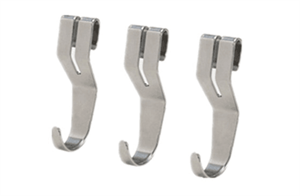Heat Treatment Of Spring Clip Fasteners
The heat treatment of Spring Clip Fasteners is a crucial process step to improve their mechanical properties, stability, and durability. Heat treatment usually includes processes such as heating, insulation, and cooling, which can alter the microstructure of materials and thereby affect their macroscopic properties.
In the heat treatment of Spring Clip Fasteners, the main factors considered include the type of material (such as carbon steel, stainless steel, alloy steel, etc.), the shape and size of the spring, and the required mechanical properties (such as hardness, elasticity, corrosion resistance, etc.). The following are some common heat treatment methods and purposes:
Quenching: Quenching is the process of heating Spring Clip Fasteners above the critical temperature and then rapidly cooling them. This process can significantly improve the hardness, strength, and wear resistance of the material, but it may also increase its brittleness. Quenching is commonly used to improve the elasticity and rebound force of springs.
Tempering: Tempering is a heat treatment step carried out after quenching, where Spring Clip Fasteners are heated to a temperature below the critical temperature, held for a period of time, and then slowly cooled. Tempering can reduce the brittleness of quenched materials while maintaining a certain level of hardness and strength. By adjusting the tempering temperature and time, Spring Clip Fasteners with different mechanical properties can be obtained.
Aging treatment: Aging treatment is the insulation treatment of Spring Clip Fasteners at a certain temperature and time to eliminate or reduce residual stresses generated during processing or heat treatment. This helps to improve the stability and durability of the spring.
Surface hardening treatment: For Spring Clip Fasteners that need to improve surface hardness and wear resistance, surface hardening treatment can be used, such as carburizing, nitriding, induction heating quenching, etc. These treatments can significantly improve the hardness and wear resistance of the spring surface without changing the overall performance of the material.
During the heat treatment process, it is necessary to strictly control parameters such as heating temperature, insulation time, and cooling rate to ensure the required mechanical properties are obtained. In addition, special attention should be paid to the safe operation of heat treatment equipment and the storage conditions of materials to prevent safety accidents and material deterioration.
Heat treatment is an indispensable step in the manufacturing process of Spring Clip Fasteners. Through a reasonable heat treatment process, the mechanical properties, stability, and durability of Spring Clip Fasteners can be significantly improved.
